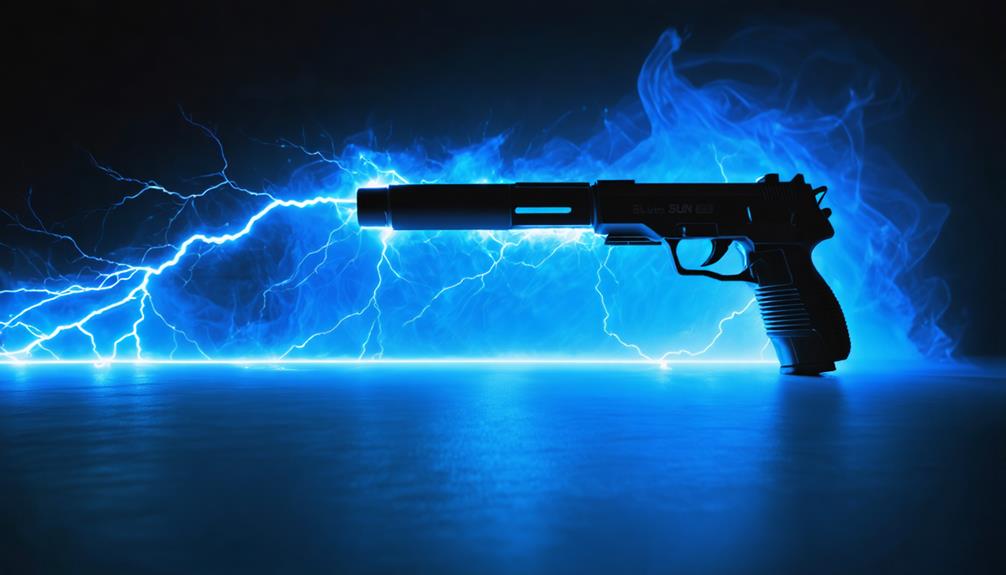
Brainstorm Security Shop

For Orders Over $199

On Any Of Our Products

Details On Refund Page
Stun gun voltage is a pivotal factor determining effectiveness and safety, yet it is often misunderstood. While higher voltage can enhance the device’s ability to penetrate thick clothing and provide a quick response, the real impact lies in the interplay between voltage and amperage. This delicate balance significantly influences the physiological effects on the human body. Moreover, the legal landscape surrounding permissible voltage levels adds another layer of complexity. How do these elements interact, and what should consumers consider when selecting a stun gun for personal safety needs?
Understanding the intricacies of voltage and amperage is crucial for comprehending how stun guns operate. These devices rely on a delicate balance between voltage and amperage to deliver a non-lethal yet incapacitating effect.
Voltage measurement is pivotal, as it indicates the potential difference that drives the electric current through the target’s body. Higher voltage in stun guns typically means the ability to penetrate thicker clothing and reach the skin, ensuring effectiveness in various scenarios. However, voltage alone does not determine the stun gun’s impact.
Amperage, on the other hand, plays a significant role in dictating the extent of the physiological response elicited by the device. Amperage differences are critical, as even slight variations can dramatically alter the outcome.
While voltage may determine the reach of an electric charge, it is the current, measured in amperes, that delivers the energy necessary to disrupt the central nervous system. Stun guns are designed to deliver a high-voltage, low-amperage shock, which is sufficient to immobilize temporarily without causing permanent harm.
Understanding how voltage measurement and amperage differences interact allows for a more comprehensive grasp of the mechanics behind stun gun operation, ensuring both efficacy and safety.
Building upon the fundamental concepts of voltage and amperage, the influence of voltage on stun gun performance becomes evident in its ability to determine the device’s effectiveness in real-world situations. A higher voltage in a stun gun is generally associated with an increased capacity to penetrate thick clothing and create a more immediate incapacitating effect. This correlation between voltage and performance underscores the importance of a proper voltage comparison when assessing stun gun efficiency.
Although higher voltage can enhance effectiveness, it is not the sole determinant of a stun gun’s overall performance. The amperage, or current, also plays a critical role. While voltage provides the necessary force to push the electrical current through a target, it is the current that disrupts the nervous system. Therefore, a balanced consideration of both voltage and current is essential for maximizing stun gun efficiency.
When evaluating different stun gun models, users must consider the interplay between voltage and other factors, such as design and battery life, to ensure optimal performance.
When evaluating stun guns, it’s crucial to weigh voltage not only for performance but also for safety considerations. A common voltage myth suggests that higher voltage equates to a more effective or dangerous device. However, stun gun safety hinges on understanding the interaction between voltage and current. While voltage measures the potential to move electrical charge, it is the current (amperage) that determines the physiological effects. Low amperage, typically found in stun guns, is generally non-lethal.
| Voltage Range (V) | Safety Consideration |
|---|---|
| 100,000 – 300,000 | High voltage myth prevalent |
| 300,000 – 500,000 | Moderate deterrent effect |
| 500,000 – 1,000,000 | Considered effective for self-defense |
| 1,000,000 – 2,000,000 | Concerns over excessive voltage |
| Over 2,000,000 | Potential risk of misuse |
Ensuring stun gun safety involves recognizing that effectiveness is not solely dependent on voltage. Devices with excessively high voltage may present risks, such as unintentional injury, without providing additional benefits for self-defense. Thus, it is vital to balance voltage with other factors like device design and user training to achieve optimal safety. As the table illustrates, understanding the relationship between voltage and safety can dispel myths and guide informed choices in stun gun selection.
In evaluating stun guns, the interplay between voltage and legal regulations cannot be overlooked. Stun guns, as self-defense tools, are subject to a myriad of legal considerations that vary significantly across jurisdictions. One of the primary legal aspects revolves around voltage standards, which can dictate the permissible power output of these devices.
While higher voltage stun guns may offer increased effectiveness, they might also face stricter regulatory scrutiny due to potential safety concerns. Legal regulations often prescribe maximum voltage limits to ensure public safety and prevent misuse. These standards aim to balance the need for effective personal protection with the imperative to mitigate risks of severe injury.
Different countries, and even states within a country, may have distinct criteria for what constitutes a legally acceptable voltage level for stun guns. For instance, some regions might completely prohibit stun guns exceeding a certain voltage threshold, while others might allow them under specific conditions or with appropriate permits.
Understanding these voltage standards is crucial for manufacturers, distributors, and consumers to comply with legal obligations. Non-compliance can result in criminal penalties, including fines and confiscation of the device. Therefore, knowledge of applicable legal regulations is indispensable for all stakeholders involved in the production, distribution, and usage of stun guns.
Selecting the appropriate voltage for a stun gun is a critical decision that balances effectiveness with safety and legal compliance. With various stun gun types available on the market, each with distinct voltage ratings, choosing the right model requires careful consideration of several factors.
High-voltage stun guns, typically ranging from 1 to 10 million volts, deliver a stronger electric shock, potentially incapacitating an assailant more rapidly. However, higher voltage does not necessarily equate to greater effectiveness, as other elements like amperage and pulse duration also play significant roles in the device’s performance.
When evaluating stun gun types, it’s essential to understand that while higher voltage ratings may provide a psychological deterrent due to their intimidating discharge sound and visible spark, they may not be legally permissible in all jurisdictions. Many regions impose restrictions on voltage levels to ensure public safety, necessitating awareness and adherence to local laws.
Moreover, the intended use and user familiarity with such devices should guide voltage selection. For personal defense, a moderate voltage stun gun might suffice for self-protection, reducing the risk of excessive force.
In essence, choosing the right voltage involves a nuanced assessment of personal needs, legal constraints, and device functionality.
A stun gun operates by utilizing a transformer and oscillator to convert low battery voltage into high voltage. This process of high voltage generation enables the device to deliver incapacitating electrical impulses upon activation.
Stun gun components typically include capacitors, transformers, and resistors, all encased in a durable plastic or metal housing. Manufacturers must adhere to stringent safety regulations to ensure reliability and prevent unintended harm during usage.
The potential for electronic device damage due to stun guns is low, but understanding stun gun safety and voltage misconceptions is crucial. Stun guns typically emit high voltage with low current, minimizing risk to electronic devices.
Stun gun voltage is measured in volts, indicating the electrical potential. Ensuring stun gun safety involves adhering to voltage regulation standards, which dictate permissible voltage levels to prevent harm while maintaining effective incapacitation capabilities. Compliance ensures device reliability and user safety.
Voltage effectiveness varies across animal species due to differing animal sensitivity. Various voltage levels are designed to accommodate these differences, ensuring humane use and minimizing harm. Proper understanding of species-specific sensitivity is crucial in determining appropriate voltage application.
